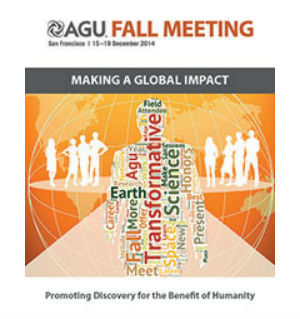American Geophysical Union Fall Conference in SF – Dec 15-19
Climate Science World Event: Want to understand more about the effect of black carbon emissions on ice and snow reflectivity in Asia? Or about the atmospheric waves linked to warming that can heat some earth areas while plunging other areas into frigid cold? These and myriad other current topics related to climate change are on the agenda during the 15-19 December American Geophysical Union fall meeting at the Moscone Center in downtown San Francisco. Nearly 24,000 participants will attend more than 1700 scientific sessions dealing with a wide range of earth and space science research.
The latest atmospheric and oceanic scientific findings that frequent the daily headlines will draw special attention, as scientists from around the globe drill down into the latest evidence that the world we live in is changing due to human activities. And if participants don’t want to focus too much on individual report minutia, they can participate in “SWIRL” sessions, where topics of broad inter-disciplinary interest are addressed. This year, some SWIRL sessions include developments in carbon sequestration, the rapid loss of glacial and polar ice, and the science of soil maintenance and fertility. The official program conveys the AGU meeting’s scope and importance: “The meeting offers a unique mix of more than 23,000 oral and poster presentations, a broad range of general sessions, more than 50 formal and informal networking and career advancement opportunities, and an exhibit hall packed with approximately 250 exhibitors showcasing new and relevant research tools and services that could help scientists and researchers streamline their work.”
In the coming weeks I will report on general and specific topics of scientific research on display at the AGU meeting. While the influences of carbon dioxide, methane, and nitrous oxide on global warming are well understood from both a theoretical and observational perspective, other factors in climate change, its prevention, and its mitigation, deserve more public attention and will be included in my coverage.
Aerosols (mostly dust and chemical particle pollutants), for example, are one of the trickier contributors to climate change that demand attention, and many AGU sessions deal with this subject. While they are short-lived in the atmosphere (rain returns them to earth rather quickly), aerosols presence on snow and ice affect planetary albedo (reflection of light energy back to space) and this is an area of ongoing research. Another area of focus includes how aerosols effectively shade many (especially urban) areas, masking temperature changes due to greenhouse gases.
Oceanic research remains an area of particular focus, with acidification and warming both topics of critical interest. The field of paleooceanography, the exploration of the biochemistry, temperature, and other conditions of ancient seas, offers historical templates by which scientists can qualify and quantify changes in our oceans today. Ocean acidification, an area of great public interest, threatens the formation of a range of planktons and other small-shelled creatures, and thus the entire ocean food chain.
Researchers from around the world attend the conference, allowing cross disciplinary contacts, networking events, and new ideas for research. Young scientists meet and learn from leading researchers in their fields of study. The conference will pay particular attention on how scientists and the press can better convey scientific research and its conclusions to the public at large.
Andy Ferguson
